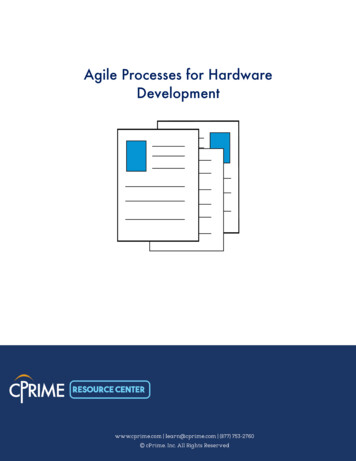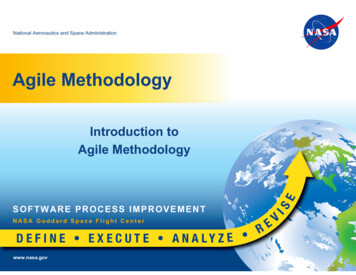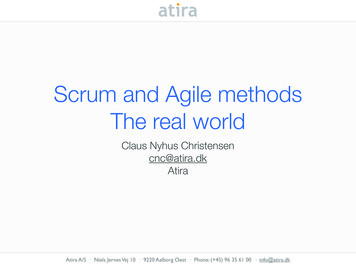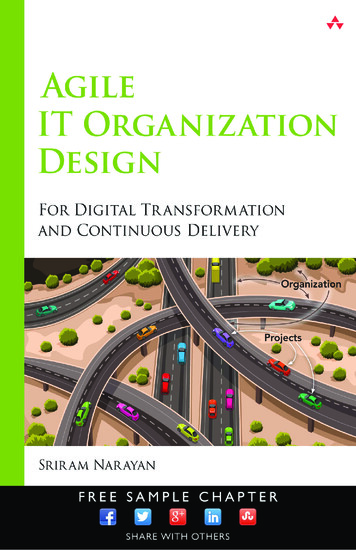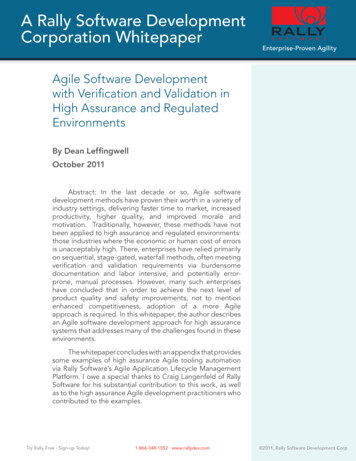
Transcription
A Rally Software DevelopmentARally Software DevelopmentCorporation WhitepaperCorporationWhitepaper1Agile Software Developmentwith Verification and Validation inHigh Assurance and RegulatedEnvironmentsBy Dean LeffingwellOctober 2011Abstract: In the last decade or so, Agile softwaredevelopment methods have proven their worth in a variety ofindustry settings, delivering faster time to market, increasedproductivity, higher quality, and improved morale andmotivation. Traditionally, however, these methods have notbeen applied to high assurance and regulated environments:those industries where the economic or human cost of errorsis unacceptably high. There, enterprises have relied primarilyon sequential, stage-gated, waterfall methods, often meetingverification and validation requirements via burdensomedocumentation and labor intensive, and potentially errorprone, manual processes. However, many such enterpriseshave concluded that in order to achieve the next level ofproduct quality and safety improvements, not to mentionenhanced competitiveness, adoption of a more Agileapproach is required. In this whitepaper, the author describesan Agile software development approach for high assurancesystems that addresses many of the challenges found in theseenvironments.The whitepaper concludes with an appendix that providessome examples of high assurance Agile tooling automationvia Rally Software’s Agile Application Lifecycle ManagementPlatform. I owe a special thanks to Craig Langenfeld of RallySoftware for his substantial contribution to this work, as wellas to the high assurance Agile development practitioners whocontributed to the examples.Try Rally Free - Sign-up Today!1-866-348-1552 www.rallydev.com 2011, Rally Software Development Corp
A Rally Software DevelopmentCorporation Whitepaper2ContentsIntroduction. 3Agile Crosses the Chasm to High Assurance Development. 4Introduction to Medical Device Exemplar. 5Regulations and Guidelines for Medical Device Development. 5Regulations. 6Guidelines. 7Software Verification, Validation, and Traceability. 7Software Requirements Specification. 8FDA Guidance is for Concurrent Engineering, NOT Waterfall Development. 9Scaled Agile Delivery Model. 12An Agile, High Assurance Lifecycle Model. 13System Intent, Vision and Product Requirements Document. 14Iterating and Continuous Verification. 15Iterating. 16Define Build Test Teams. 17Agile Requirements Backlog Model. 18User Stories as Software Requirements Specification. 18User Story Verification. 19Traceability from User Story to Code. 20Traceability from Code to Unit Tests. 20Traceability to User Story Acceptance Tests. 20User Story Validation. 21Validating System Increments. 22Validation Sprint Length. 23PRD to SRS Traceability. 23Testing Features. 24Testing Nonfunctional Requirements. 27Finalizing Documents. 29Finalizing Traceability Matrices. 29Conclusion. 29Bibliography. 31About the Author. 32About the Primary Contributor. 32Appendix. 33Try Rally Free - Sign-up Today!1-866-348-1552 www.rallydev.com 2011, Rally Software Development Corp
A Rally Software DevelopmentCorporation Whitepaper3IntroductionOver the last two decades, the movement to iterative, and now Agiledevelopment methods has been one of the most important trends affectingthe software industry. In Scaling Software Agility [Leffingwell, 2007], I describedhow Agile methods left the realm of small software teams and programs and arenow being applied at enterprise scale. As the methods were relatively new(er)at the time, I highlighted many of the documented benefits, including increasesin productivity, quality, team morale and job satisfaction. In turn, Agile softwareenterprises receive the ultimate beneficial result – improved economic outcomes,higher safety, value, convenience, efficiency, efficacy, and indeed, better standardsof living for society at large – that accrue when we improve on this strange mix ofart, science and engineering that we call software development.When it comes to software quality, it comes as no surprise to Agile proponentsthat, when properly implemented, Agile development achieves much higherquality than its waterfall predecessor. The tyranny of the urgent-defect-triage-endgame is largely mitigated. And while we will always need to address defects, nonconformances and minor user-need misfires, with Agile we can focus far more ontwo primary things: 1) better understanding user needs, and 2) building softwarethat has quality, including safety and security, as its organic basis. Given this focus,we now find Agile in another mainstream: those enterprises developing softwarefor medical equipment, pharmaceutics, avionics, military systems, financial tradingsystems and other high assurance applications. Here, the presence of any materialdefect may have an unacceptable human or economic cost.In this whitepaper, we describe an Agile approach to developing highassurance software systems. As a baseline, we will explore regulations andguidance associated with the development of medical systems as regulated by theUS FDA and similar international agencies. While this will be our example, manyother high assurance industries have similar regulations and requirements, andmost assume the need to verify and validate our requirements and the resultantsoftware application to be sure that our solution works as, and only as, intended.We describe an Agile lifecycle model that supports the business needfor constant feedback and risk identification and mitigation, and lessens thedependencies on abstract, document-oriented milestones. In its place, we willuse working code as the basis for feedback and decision-making. We suggestverification and validation activities and artifacts that support our need to make surethe system works only and exactly as we intended, and simultaneously providestraceability mechanisms we need to demonstrate these facts to other stakeholders,including regulatory bodies. The appendix provides examples, screenshots andexplanations for various reports and artifacts that we can generate using Agiletooling solutions such as Rally Software’s Agile Application Lifecycle ManagementPlatform, HP’s Quality Center, and Subversion version control systems.Try Rally Free - Sign-up Today!1-866-348-1552 www.rallydev.com 2011, Rally Software Development Corp
A Rally Software DevelopmentCorporation Whitepaper4Agile Crosses the Chasm to High AssuranceDevelopmentBefore we proceed, it is important to know that there is already substantialevidence of successful adoption of Agile development methods in high assuranceindustries. For example, in Adopting Agile in an FDA Regulated Environment[Abbott 2009], Abbot Labs describes how they applied Agile methods in thedevelopment of a nucleic acid purification platform in its Molecular Diagnosticsbusiness. They also took the time to compare results using the Agile method witha similar predecessor project built using waterfall practices. The conclusions arecompelling:(On the new project): Fewer defects were found the availability ofworking software, early on was a significant factor.(By comparison to the prior project): We estimate that using an Agileapproach would have resulted in the overall project duration beingreduced by 20-30%.a headcount reduction of 20-30%. and a netcost savings of 35-50%.(In conclusion): This experience has convinced us that an Agileapproach is the approach best suited to development of FDAregulated devices.As further evidence of this trend, the Association for the Advancement ofMedical Instrumentation (AAMI) is developing a Technical Information Report,which should be available later this year, which will provide recommendations forcomplying with international standards and FDA guidance documents when usingAgile practices to develop medical device software1.Agile development is also making significant inroads into other high assuranceindustries, including none other than the US Department of Defense. David Ricocommented on a recent AFEI2 DoD Agile Development Conference dedicated topromoting Agile acquisition and IT development practices3:It reinforced the U.S. DoD’s commitment to the use of AgileMethods. Furthermore, it was interesting to see that Agile Methodsare in widespread use by the U.S. DoD, and that no individualorganization, project, group, or person is practicing them in isolation.Prior both the commercial industry and DoD contractors believedthe U.S. DoD was not committed to Agile Methods, which is anenormously incorrect assumption .It’s a popular urban legendthat the DoD uses (only) traditional methods such as DoD 5000,CMMI, PMBoK, and other waterfall-based paradigms to develop ITintensive systems. The AFEI DoD Agile Development Conferenceshattered that myth completely.See m?WebID P1541 D6110The Association for Enterprise Information (AFEI). See http://www.afei.org/Pages/default.aspx.3See http://davidfrico.com/afei-2010.doc12Try Rally Free - Sign-up Today!1-866-348-1552 www.rallydev.com 2011, Rally Software Development Corp
A Rally Software DevelopmentCorporation Whitepaper5Introduction to Medical Device ExampleThe domain of high assurance development is extremely broad, andregulations and interpretations vary from industry to industry. In this whitepaper,we use medical device development under the auspices of the US Food andDrug Administration as an example regulatory environment. In our experience,the expectations for practices and compliance in this industry are quite similarto many others, so if we understand this one instance, then we might be ableto understand something about them all. However, the following disclaimer isappropriate:Regulatory requirements for software differ from industry to industry,and interpretations and enforcement practices are constantly changing.Any suggestions provided in this whitepaper do not constitute legalor regulatory advice. Information in this whitepaper should only beapplied by qualified professionals with direct knowledge of theirspecific industry.With that disclaimer out of the way, let’s look at regulations and guidance fordevelopment of medical devices under the auspices of the US FDA.Regulations and Guidelines for Medical Device DevelopmentEach industry has its own thicket of regulatory bodies and publishedstandards that must first be parsed for understanding. Figure 1 describes a chainof both regulatory and guidance documents that govern medical device softwaredevelopment as provided for under the US FDA Code of Federal Regulations(CFR) 214.Note: while this post and thread focuses on US FDA Good Manufacturing Practices (GMP) requirements for medical devices,these requirements are generally harmonized with International Organization for Standards (ISO) 9001:1994 and ISO DIS 13485.4Try Rally Free - Sign-up Today!1-866-348-1552 www.rallydev.com 2011, Rally Software Development Corp
A Rally Software DevelopmentCorporation Whitepaper6FEDERAL REGULATIONSCode of Federal Regulations (CFR)Title 21- Food and DrugAdministration (CFR21)Chapter I – Food and Drug AdministrationDepartment of Health and Human ServicesCFR 21 Part 820 Quality System Regulation (1997)Gual idal d ncev eic foresFDA PROVIDED GUIDANCECFR 21 Subchapter H - Medical DevicesDesign Control Guidance for MedicalDevice Manufacturers CDRH 1997.CFR21 Part 820.30 Subpart C Design Controlsesic eev arr d twfo sofenc ingda inui taG oncCFR21 Part 820.30 Subpart C(f) Verification and (g) ValidationGeneral Principles of Software Validation;Final Guidance for Industry and FDA StaffCDRH 2002Figure 1 Regulatory and guidance documents for US medical device developmentA summary explanation of these documents is provided in the paragraphs below.RegulationsIn our case, the law starts with the US Code of Federal Regulations (CFR),which is the law of the land in the U.S. Title 21 of the CFR is reserved for rules of theFood and Drug Administration (FDA). Here, we find the following additional “sub”regulations.CFR 21 Subchapter H – Medical Devices. Covers the general design,manufacture and marketing of medical devices.CFR 21 Part 820 Quality System Regulation. Defines specificregulatory requirements for the design and development of suchdevices, intended to ensure that finished devices will be safe andeffective and otherwise in compliance with the Federal Food, Drug,and Cosmetic Act.Quality System Regulation, CFR21 Part 820.30 Subpart C DesignControls. Subpart C specifies the regulations for device design (includingsoftware development in our case). Regulatory requirements for deviceverification and validation are included here.Try Rally Free - Sign-up Today!1-866-348-1552 www.rallydev.com 2011, Rally Software Development Corp
A Rally Software DevelopmentCorporation Whitepaper7GuidelinesCFR 820.30 is the regulation that covers all medical devices, whether theyinclude software or not. It is remarkably short (just 2 pages!) and provides lots ofleeway to device manufacturers. It is important to note that this document, at thebottom of the chain, contains all of, and the only specific federal regulations whichgovern medical device development.However, as an aid to FDA staff and the industry, CDRH has published additionalguidelines that add specificity to how these regulations will be interpreted. First,for 820.30, Design Controls, there is the publication Design Control Guidance forMedical Device Manufacturers [FDA CDRH 1997]. It is important to note that theseguidelines are just that—guidelines—and they do not have the force of regulation.However, they do set expectations on the part of the industry and regulators as tohow the regulations should generally be interpreted.And finally, and more specifically to our context, CDRH has publisheda document which provides guidelines for the general principles of softwarevalidation, General Principles of Software Validation; Final Guidance for Industryand FDA Staff [FDA CDRH 2002].Software Verification, Validation and TraceabilityCFR 21 Part 830 Subpart C Design Controls, Paragraphs (f), (g) mandate devicedesign verification and validation. In General Principles of Software Validation[FDA CDRH 2002], we find:Software verification provides objective evidence that the designoutputs of a particular phase of the software development lifecyclemeet all of the specified requirements for that phase. Softwareverification looks for consistency, completeness, and correctnessof the software and its supporting documentation, as it is beingdeveloped, and provides support for a subsequent conclusion thatsoftware is validated.In other words, verification ensures that “you built it right.”Software validation is confirmation by examination and provisionof objective evidence that software specifications conform to userneeds and intended uses, and that the particular requirementsimplemented through software can be consistently fulfilled. Sincesoftware is usually part of a larger hardware system, softwarevalidation typically includes evidence that all software requirementshave been implemented correctly and completely and are traceableto system requirements.In other words, validation ensures that “you built the right thing.”Try Rally Free - Sign-up Today!1-866-348-1552 www.rallydev.com 2011, Rally Software Development Corp
A Rally Software DevelopmentCorporation Whitepaper8In addition, the guidelines go on to describe traceability and traceabilityanalysis as primary mechanisms to assure that verification and validation arecomplete and consistent, and that a traceability matrix is the documentation recordthat provides the objective evidence of the completeness of the verification andvalidation. For definitions here, we refer to FDA Glossary of Computer SystemsSoftware Development Terminology5:Traceability. (from IEEE) (1) The degree to which a relationship canbe established between two or more products of the developmentprocess, especially products having a predecessor-successor or mastersubordinate relationship to one another; e.g., the degree to which therequirements and design of a given software component match. (2)The degree to which each element in a software development productestablishes its reason for existing.Traceability Analysis. (from IEEE) The tracing of (1) SoftwareRequirements Specifications requirements to system requirements inconcept documentation, (2) software design descriptions to softwarerequirements specifications and software requirements specificationsto software design descriptions, (3) source code to correspondingdesign specifications and design specifications to source code. Analyzeidentified relationships for correctness, consistency, completeness,and accuracy.Traceability Matrix. (from IEEE) A matrix that records the relationshipbetween two or more products; e.g., a matrix that records therelationship between the requirements and the design of a givensoftware component.Software Requirements SpecificationIn addition to these definitions, this document [FDA CDRH 2002] also providesan introduction and definition to another important artifact:A documented software requirements specification (SRS) provides abaseline for both validation and verification. The software validationprocess cannot be completed without an established softwarerequirements specification (Ref: 21 CFR 820.3(z) and (aa) and 820.30(f)and (g).From the guidance, such a document typically contains: All software system inputs, outputs, and functions All performance requirements, including throughput, reliability, accuracy,response times (i.e., all nonfunctional requirements) Definition of external and user interfaces User interactions Operating environments (platforms, operating systems, other applications) All range limits, defaults and specific values the software will accept All safety-related requirement specifications, features or functionsimplemented in software5 see FDA Glossary of Computer Systems Software Development Terminology online at des/ucm074875.htmTry Rally Free - Sign-up Today!1-866-348-1552 www.rallydev.com 2011, Rally Software Development Corp
A Rally Software DevelopmentCorporation Whitepaper9Clearly, the verification and validation (V&V) aspects of the regulationsessentially mandate the creation a software requirements specification6. Incontrast, non-high assurance Agile development teams don’t typically createthese in a formal way; instead they use the backlog, collections of user storiesand acceptance criteria, persistent test cases and the code itself to documentsystem behavior. However, in this context, it is clear that we will need to developand maintain a software requirements specification, as we simply cannot do V&Vwithout it. However, the fact that we need such a document doesn’t mandatethat we do it all Big and Up-Front. Indeed. To be Agile, we can and will developit incrementally.FDA Guidance is for Concurrent Engineering,NOT Waterfall Development[FDA CDRH 2002] (40 pages) provides the most specific guidance applicableto the validation of medical device software. It is important to note, that neitherthis document, nor CFR820.30 itself, constrains development to single pass, stagegated, waterfall activities.From General Principles of Software Validation [FDA CDRH 2002]:This guidance recommends an integration of software life cyclemanagement and risk management activities. While this guidancedoes not recommend any specific life cycle model or any specifictechnique or method, it does recommend that software validationand verification activities be conducted throughout the entiresoftware life cycle.From Design Control Guidance for Medical Device Manufacturers[FDA CDRH 1997]: Although the waterfall model is a useful tool forintroducing design controls, its usefulness in practice is limited for more complex devices, a concurrent engineering model is morerepresentative of the design processes in use in the industry.Even more specifically, IEC62304 (a widely recognized internationalstandard for medical device software which is largely harmonizedwith FDA’s interpretation of CFR 820.30) states: these activitiesand tasks may overlap or interact and may be performed iteratively orrecursively. It is not the intent to imply that a waterfall model shouldbe used.6 For further description of the contents of an SRS, refer to IEEE Recommended Practice for Software Requirements Specificationsand Managing Software Requirements: A Unified Approach [Leffingwell and Widrig 1997].Try Rally Free - Sign-up Today!1-866-348-1552 www.rallydev.com 2011, Rally Software Development Corp
A Rally Software DevelopmentCorporation Whitepaper10Notwithstanding the above, and whether we are doing high assurancedevelopment or not, it is likely that our enterprise’s standard approach to softwaredevelopment followed the over-simplified waterfall model. After all, that’s whatmost of us have done for years, so why would the high assurance developmentteams be any different? To be flippant for a moment, perhaps we headed downthis path because it’s simply easier to draw. Perhaps we have done so because thelinear waterfall SDLC phase gates are so easy to map to milestones for managementand they fit in so neatly with linear management forecasts and budgets for formalphase gate reviews (i.e., SRR, PDR, CDR, TRR, etc.). For example, in describing theapplication of design controls, [FDA CDRH 1997] provides the following ignOutputVERIFICATIONMedicalDeviceVALIDATIONFigure 2 Application of design controls to waterfall design process. From [FDACDRH 1997] Design Control Guidance for Medical Device ManufacturersMost readers will recognize Figure 2 as being typical of more generic,traditional waterfall software development process models, such as that picturedin Figure 37.SoftwareRequirementsDesign andAnalysisCodingTestingDeploymentFigure 3 A traditional waterfall model view of software development7Note to the software historians: Winston Royce’s seminal 1970 article, which initially described the sequential model which cameto be known as the waterfall model, included the following statement “I believe in this concept (analysis before coding etc), but theimplementation above (a sequential, single pass, reqs-analysis-design-coding-testing) is risky and invites failure.” In other words, heconcluded that the waterfall model, as we often imply today is NOT a recommended model for development.Try Rally Free - Sign-up Today!1-866-348-1552 www.rallydev.com 2011, Rally Software Development Corp
A Rally Software DevelopmentCorporation Whitepaper11In addition, V&V activities are aligned with the commonly known V-modeldepicted in Figure 4 below. In the V-model, each phase of development is alignedwith the specific V&V activities, which includes testing for each phase.V MODELPRODUCTACCEPTANCE TESTCONCEPTSYSTEM TESTREQUIREMENTSINTERGRATION TESTDESIGNCODEUNIT TESTFigure 4 A traditional V Model view of software development phasesaligned with V&V and testing phasesSuch diagrams, familiar to us all, offer some positive attributes, at least onthe surface: It is seemingly simple and logical (what could be more logical than codefollowing requirements, and tests following that?) In theory, you only have to do “it all” once (especially verification andvalidation, which can be both labor intensive, expensive and error prone)Of course, we know it doesn’t work well that way, and that’s why we strive foragility in the high assurance markets, just like we do everywhere else. However,for many, the apparently beguiling (but false) simplicity of the model is one reasonthat it has made its way into the various governing documents, milestone reviews,corporate quality standards, etc.Let us be clear: with respect to this one industry, and with respect to thesespecific guidelines, any notion that we are mandated to apply a single-pass,waterfall model to software development is an industry myth, one which has likelybeen perpetuated by our own waterfall past (“we have always done it this way”)and our existing quality management systems, and not because “the regulationsmake us do it.”Try Rally Free - Sign-up Today!1-866-348-1552 www.rallydev.com 2011, Rally Software Development Corp
A Rally Software DevelopmentCorporation Whitepaper12Scaled Agile Delivery ModelAs we noted earlier, many enterprises have already moved to a scalableAgile development model. In Agile Software Requirements [Leffingwell, 2011], Iproposed a Scaled Agile FrameworkTM which is illustrated by a “Big Picture” ofAgile development in the enterprise context. 2 0 1 1 L effi n g w el l , L L C .!! !6'6'6'6'!!Figure 5 Scaled Agile Framework Big PictureSource: Agile Software Requirements: Lean Requirements Practices for Teams,Programs and the Enterprise. Addison-Wesley 2011.This model has a number of interesting attributes, many of which we will beable to apply directly to our high assurance context: Software development proceeds in a short series of iterations (or Sprints) For requirements, Agile teams work against their local, project backlog,which consists primarily of user stories that are written just prior to theiteration in which they are implemented Teams break stories down into tasks, which is a fine-grained workbreakdown structure (which we will put to good use shortly) Teams work against a common program backlog, comprised of a set offeatures which describe the system intent, or solution Vision Periodically, the teams collaborate on a hardening sprint, used toeliminate any remaining technical debt, perform full system integrationand regression testing, and to finalize documentation At the end of each hardening sprint, the program has produced a release(or Potentially Shippable Increment) of the full software asset stackTry Rally Free - Sign-up Today!1-866-348-1552 www.rallydev.com 2011, Rally Software Development Corp
A Rally Software DevelopmentCorporation Whitepaper13An Agile, High Assurance Lifecycle ModelThe Agile model above is fairly robust and scalable, and has been successfullyapplied in a number of industries. However it does not assume the developmentof specific requirements documents, nor explicit verification and validation, so weneed to extend this a bit in the high assurance context. With a nod to the modelabove and the Abbott Labs whitepaper [Abbott 2009], and with due respect tothe necessary verification and validation activities, we offer Figure 6 as a model forAgile, iterative and incremental development in high assurance markets:A HIGH ASSURANCE, AGILE SOFTWARE DEVELOPMENT LIFECYCLE PROCESS VSYSTEMINCREMENTSValidateReviewPERIODIC VALIDATIONCONTINUOUS VERIFICATIONSYSTEM ITERATIONSVDesignTransferRProduction CodeFigure 6 An Agile, high assurance lifecycle modelIn this model, we use a series of short system iterations, each of w
1-866-348-1552 www.rallydev.com 2011, Rally Software Development Corp A Rally Software Development Corporation Whitepaper 4 Agile Crosses the Chasm to High Assurance Development Before we proceed, it is important to know that there is already substantial evidence of successful adoption of Agile d



